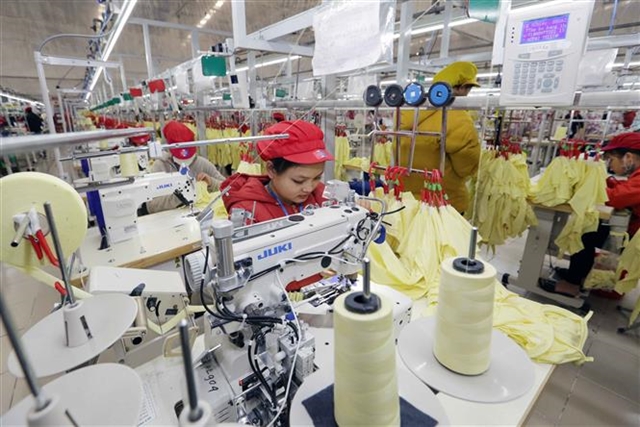Fashioning a greener future for Việt Nam’s garment industry with global collaboration
Việt Nam News reporter Mai Hương spoke with Jeremy Lardeau, senior vice president of the Higg Index at Cascale, about key challenges, opportunities, and global partnerships driving the sector’s shift to a low-carbon economy.

As Việt Nam’s apparel and footwear sector works to reduce its carbon footprint and align with global sustainability goals, collaboration across the industry is becoming more crucial than ever. Việt Nam News reporter Mai Hương spoke with Jeremy Lardeau, senior vice president of the Higg Index at Cascale, a global non-profit alliance driving sustainability in the consumer goods industry, about the sector's challenges, opportunities and the role of international partnerships in the transition to a low-carbon economy.
What are the main challenges that Việt Nam’s apparel and footwear sector faces in reducing carbon emissions, and how can collaboration across the industry help address them?
The sector faces critical sustainability challenges, as Cascale’s new Việt Nam Country Report highlights, particularly in energy consumption, carbon emissions, and resource efficiency.
In Việt Nam, the apparel and footwear industry accounts for 8 per cent of industrial energy demand and emits around five million tonnes of CO₂ annually. Additionally, 12 per cent of apparel and footwear facilities use coal for energy, while renewable energy accounts for less than 2 per cent of the sector’s energy use.
Encouragingly, nearly 100 textile and footwear businesses have now been specifically designated to report their emissions, aligning with Việt Nam’s broader goal of achieving net-zero emissions. There is also a growing emphasis within the industry on transitioning to renewable energy sources.
Việt Nam aims to raise renewable electricity to 10 per cent by 2025 and cut energy use by 0.4 to 0.7 per cent each year from 2021 to 2030. To support this ambition, the Vietnamese Government’s recent passing of legislation enabling Direct Power Purchase Agreements marks a significant step forward.
Another major challenge is the use of biomass. Our 2023 Higg Facility Environmental Module (Higg FEM) data showed issues like uncertified biomass and poor wastewater treatment in textile facilities. As costs rise, some suppliers have switched to uncertified wood waste, which can have a bigger environmental impact than coal and pose serious risks.
This is why collaboration across the industry to address practices like these is so important. By working together across the value chain, apparel and footwear companies — as well as others in the consumer goods sector — can play a pivotal role in Việt Nam’s transition to a sustainable, low-carbon economy while simultaneously enhancing business performance.
What specific opportunities can local manufacturers leverage to boost competitiveness and attract international brand partnerships?
There are many opportunities that local manufacturers can leverage to boost competitiveness and become more attractive to international brands.
One key opportunity is renewable energy adoption. Việt Nam is committed to supply chain decarbonisation and is placing increasing emphasis on renewable energy. Local manufacturers that transition to renewable sources can reduce emissions and align with international sustainability standards.
Another opportunity is using available data. Tools like the Higg FEM help manufacturers spot ways to improve energy use, cut emissions, and use resources more efficiently. At the same time, circular economy practices are growing in Việt Nam’s textile and footwear sectors. Adopting these can help manufacturers attract eco-conscious global brands.
Việt Nam presents an evolving landscape with strong potential for facilities to contribute meaningfully to decarbonisation goals. The same principles that attract brand partnerships — renewable energy, data-driven insights, and circular practices — are also the levers to reduce emissions.

What practical steps can international fashion brands take to support their suppliers in Việt Nam in transitioning away from coal?
As Việt Nam continues to develop and embrace sustainability, there are many opportunities for international fashion brands to support their suppliers in moving away from coal and help lead the transformation of supply chains.
One practical step is engaging in low-carbon transitions. Brands can support their Vietnamese suppliers by investing in renewable energy projects and helping them access Power Purchase Agreements (PPAs) to procure clean energy. Providing technical guidance and resources to assess energy needs and implement effective renewable solutions is also crucial.
Additionally, fostering long-term partnerships is vital. Multi-year commitments can build trust and stability, giving suppliers the confidence to invest in renewable energy. These partnerships may also involve setting shared sustainability targets and timelines for reducing coal dependency.
Supporting workforce skill development is another key action. Brands can co-develop training programmes or sponsor participation in existing initiatives to help supplier employees build expertise in energy efficiency, sustainability, and green technologies.
Finally, brands must monitor and respond to policy changes. Staying informed about Việt Nam’s evolving energy landscape and helping suppliers comply with regulatory updates — while taking advantage of new sustainability incentives — can further accelerate the move away from coal.
You’ve mentioned that investing in sustainability goes beyond compliance — it’s also about long-term competitiveness. In your view, what are the key benefits for manufacturers that take early action on sustainability?
The benefits are clear. Companies that take meaningful action today will be better positioned for the future. Sustainability is not only a moral responsibility — it is the key to long-term competitiveness and business continuity.
Việt Nam’s economy is expected to grow by 6.5 per cent in 2025, ahead of its regional peers. Manufacturing, which made up 23.88 per cent of GDP in 2023, continues to drive this growth. With plans to boost renewable energy use to 65–70 per cent by 2045, companies that act early will have an advantage over those holding on to old practices.
Cascale is driving this shift with its Industry Decarbonisation Roadmap, a joint effort to cut greenhouse gas emissions across the textile, apparel, and footwear supply chain. The initiative focuses on turning goals into action by supporting high-impact sites and promoting scalable, inclusive, and practical solutions. — VNS





